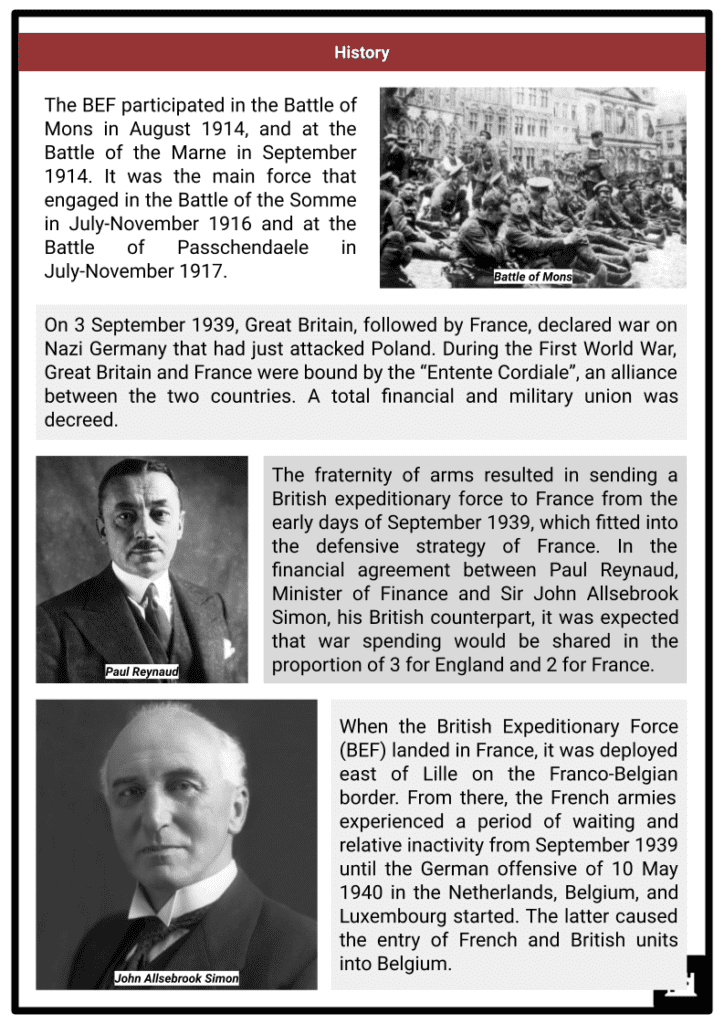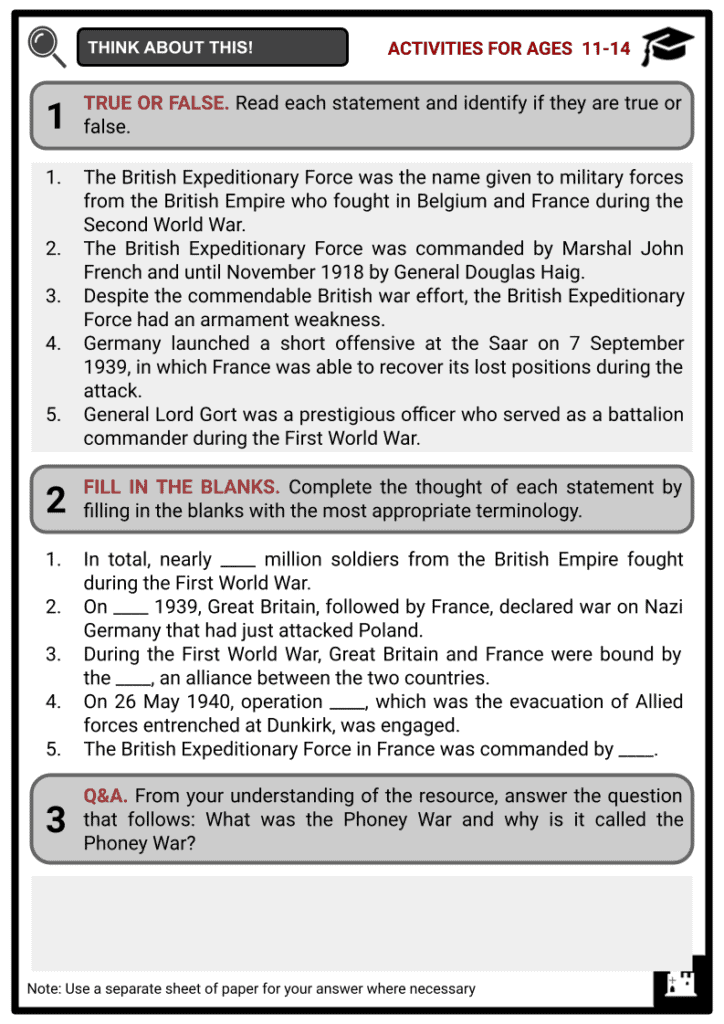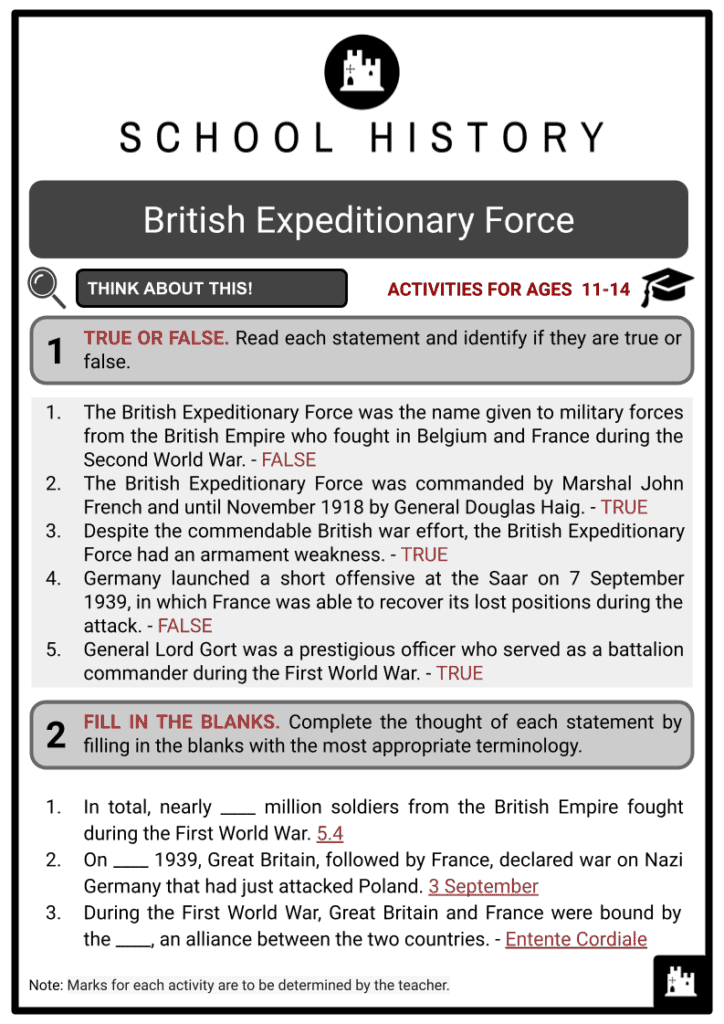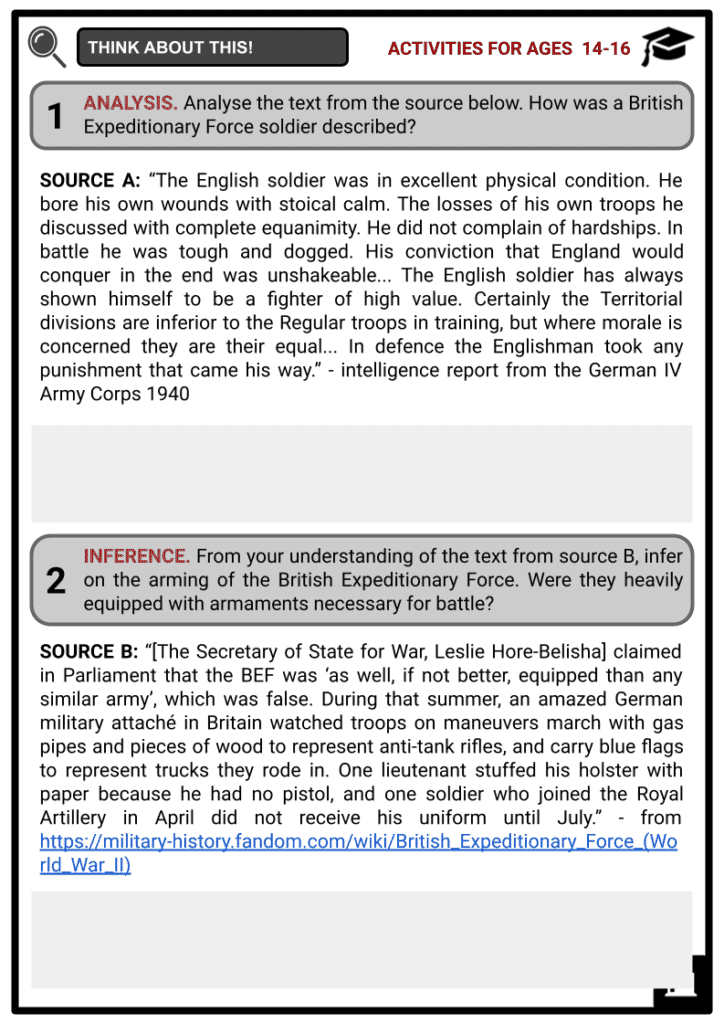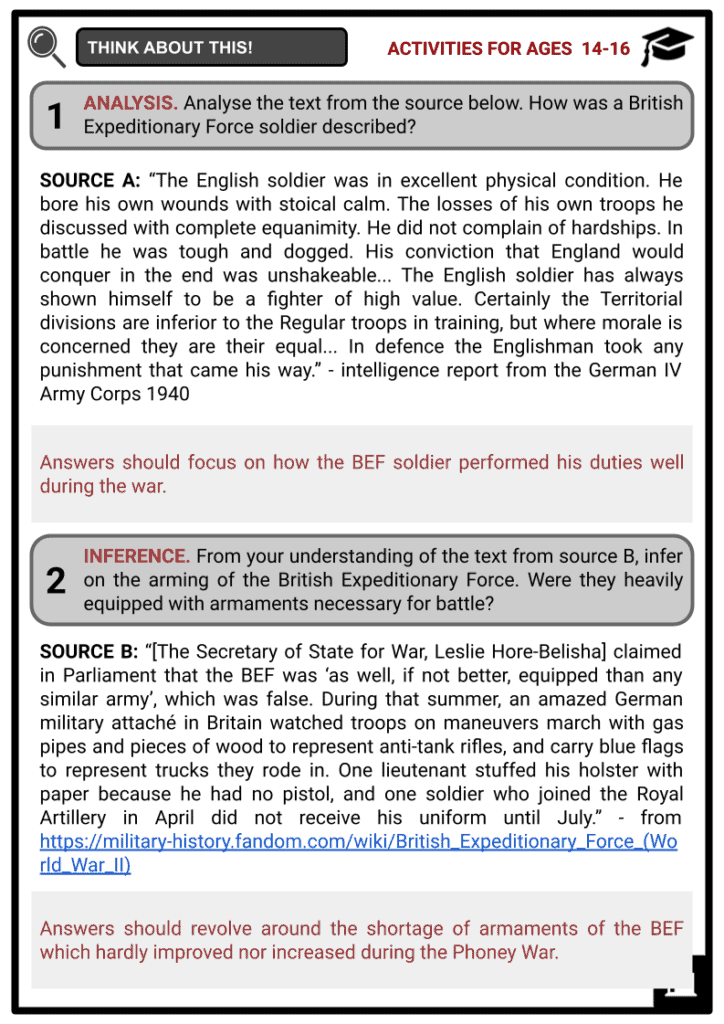British Expeditionary Force Worksheets
Do you want to save dozens of hours in time? Get your evenings and weekends back? Be able to teach about the British Expeditionary Force to your students?
Our worksheet bundle includes a fact file and printable worksheets and student activities. Perfect for both the classroom and homeschooling!
Summary
- History of the British Expeditionary Force (BEF)
- BEF Command
- Composition of the BEF
- Military Activity and Arming of the BEF
- The Phoney War
- The Last Fights and the Return of Survivors to England
Key Facts And Information
Let’s find out more about the British Expeditionary Force!
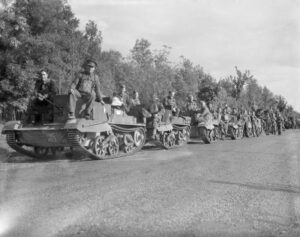
The British Expeditionary Force (BEF) was the name given to military forces from the British Empire who fought in Belgium and France during the First World War. The BEF was first trained by professional soldiers. Recruitment was quickly completed by volunteers and conscripts of compulsory military service.
In total, nearly 5.4 million soldiers from the British Empire fought during the First World War (the maximum number present at the same time on the front was 2 million combatants). From August 1914 to December 1915, the BEF was commanded by Marshal John French and until November 1918 by General Douglas Haig.
History
- The BEF participated in the Battle of Mons in August 1914, and at the Battle of the Marne in September 1914. It was the main force that engaged in the Battle of the Somme in July-November 1916 and at the Battle of Passchendaele in July-November 1917.
- On 3 September 1939, Great Britain, followed by France, declared war on Nazi Germany that had just attacked Poland. During the First World War, Great Britain and France were bound by the “Entente Cordiale”, an alliance between the two countries. A total financial and military union was decreed.
- The fraternity of arms resulted in sending a British expeditionary force to France from the early days of September 1939, which fitted into the defensive strategy of France. In the financial agreement between Paul Reynaud, Minister of Finance and Sir John Allsebrook Simon, his British counterpart, it was expected that war spending would be shared in the proportion of 3 for England and 2 for France.
- When the British Expeditionary Force (BEF) landed in France, it was deployed east of Lille on the Franco-Belgian border. From there, the French armies experienced a period of waiting and relative inactivity from September 1939 until the German offensive of 10 May 1940 in the Netherlands, Belgium, and Luxembourg started. The latter caused the entry of French and British units into Belgium.
- On 14 May, German armoured vehicles broke through into French territory in the Sedan region. This led to the retreat of Franco-Belgian-British forces to the Scheldt and the north canals. From 20 May, despite strong British resistance, the Allies were encircled and the cities of Arras, Calais, and Boulogne were captured.
-
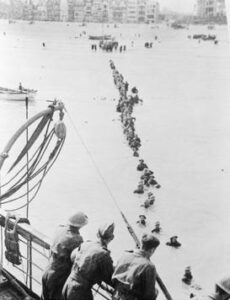
Operation Dynamo On 26 May 1940, operation “Dynamo”, which was the evacuation of Allied forces entrenched at Dunkirk, was engaged. As of 4 June, there were more than 300,000 soldiers, with 225,000 of them British, who were sent back to England.
- The BEF lost three-quarters of its heavy equipment. 3,500 of its troops were killed and many were captured as prisoners of war. There were 150,000 Britons not evacuated at Dunkirk but through other ports in June. The evidence of the SCA, kept at ECPAD, by the British Expeditionary Force in France, was distributed with forty photographic reports.
- On 26 May 1940, operation “Dynamo”, which was the evacuation of Allied forces entrenched at Dunkirk, was engaged. As of 4 June, there were more than 300,000 soldiers, with 225,000 of them British, who were sent back to England.
- The pictures showed the armed forces stationed in the French territory, their training during the Phoney War (aka funny war or strange war), from September 1939 to May 1940, and the visits of British authorities to their troops. The advance of German forces and the defeat of the Allied armies were covered by photographers of the companies’ propaganda.
Command of the BEF
- The British Expeditionary Force in France was commanded by General Lord Gort, appointed by the Imperial Chief of Staff, Field Marshal Ironside, and placed under the command of General Gamelin, Chief of the French Land Forces and Allied armies.
- General Gort was a prestigious officer who served as a battalion commander during the First World War. He was decorated with the Victoria Cross. His GHQ (General Headquarters) was moved to Arras (Pas-de-Calais) and two mission liaison were detached from the French commands. The first, under the orders of the Major-General Sir Richard Howard-Vyse, was in Vincennes, at the headquarters of General Gamelin, and the second, under the command of Brigadier J. G. R. Swayne, at the headquarters of General Georges.
Composition of the BEF
- The British troops in France, composed of professional soldiers, had four divisions in September 1939 and ten in May 1940 (reinforcements landed on 17 May) for a total of 237,000 men grouped into three army corps, services, and units in reserve of Headquarters:
- Lieutenant-General Barker’s I Corps, consisting of the 1st, 2nd, and 48th Infantry Divisions
- Lieutenant-General Brooke’s II Corps, composed of 3rd and 4th Infantry Divisions, and 50th Motor Infantry Division
- Lieutenant-General Adam’s III Corps, consisting of the 42nd and 44th Infantry Divisions
- The large main units in reserve, which would come under French command in the year 1940: 1st Armored Division (Armoured Division) and 51st Highland Infantry Division.
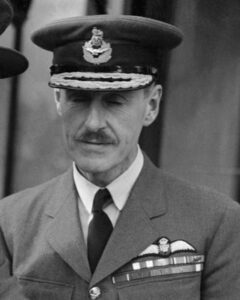
Air Vice Marshal C. Blount
Most of the armoured forces of the BEF in 1939 were: a mechanised cavalry regiment, a regiment of armoured carriages, and a tank regiment (on the 4th Royal Tank Regiment). In addition, the British Air Force and the Royal Air Force (RAF) were the Air Component, a detachment under the orders of the Air Vice Marshal C. Blount and whose mission was to support BEF troops and carry out reconnaissance missions for its benefit.
Military Activity
- As part of the maneuvers provided by the “Dyle” plan, British units were deployed on the Franco-Belgian border, east of Lille, from Maulden to Halluin:
- The 1st Corps, with the 1st and 2nd Infantry Divisions, from 3 October 1939
- The 2nd Corps, with the 3rd and 4th Infantry Divisions, did the same on 12 October 1939 (on their left flank was the 7th French Army, and on its right flank the 1st French Army)
- The 5th Infantry Division joined the BEF at the end of 1939
- The 51st Highland Infantry Division arrived in January 1940
- Five territorial divisions also followed from January 1940
- The III Corps was finally created in April 1940
Arming
- Despite the commendable British war effort, the British Expeditionary Force had an armament weakness, which hardly improved nor increased during the strange war. Staffing, particularly shielding, was very inadequate.
- On 17 May 1940, the BEF could not compete with a German Panzer-division. Moreover, most of the English tanks were of a lighter type such as the Mark VI, which exceeded the number of the newer Mark II “Matilda” heavy tanks at the time. The chariot Mark VI, which served throughout the campaign in France (May – June 1940), was a tank that weighed 5.2 tons, was armed with two Vickers machine guns, one 12.7 mm and the other 7.7 mm, and included a crew of three men.
The Phoney War: Waiting and Training
- The French launched a short offensive at the Saar on 7 September 1939, in which Germany was able to recover its lost positions during the attack. General Gamelin then ordered troops to withdraw to the Maginot Line.
- This saw a period spanning eight months marked by the relative absence of fighting in the territory despite the armies being camped at their respective defensive lines of Maginot and Siegfried. This situation gave rise to the expression “funny war”, the origin of which is disputed. An early appearance of the term appeared in a news article by Roland Dorgelès, a war correspondent, after a tour on the frontline.
- The waiting experienced during the Phoney War was insidious. Under these circumstances, the main concern of those in command was to fight “the boredom of those long months of winter and spring 1939-1940, which gnawed so much of intelligence…” as Marc Bloch testified in The Strange Defeat.
- The daily military activity of the British and French soldiers during this period alternated between observation, faction, training, patrol or skirmish, but many did not fire a single shot before May 1940.
The Last Fights and the Return of Survivors to England
- On 5 June 1940, German troops resumed offensives on the Somme and Aisne. Field Marshal Sir Alan Brooke was given command of a new II Corps, comprising the 51st (Highland) Infantry Division and the 1st Armoured Division, with the 52nd (Lowland) Infantry Division and the 1st Canadian Infantry Division, then the 3rd Infantry Division when it became ready.
- These units landed in France during the second week of June, forming a second expeditionary force. The surviving elements of these formations (approximately 150,000 men) were, in turn, evacuated to England from the ports of Bayonne, Verdon, Saint-Nazaire, Rochelle, Brest, and Cherbourg through operation “Ariel”.
Conclusion
- The Allied defeat was transformed into propaganda by Winston Churchill, Prime Minister since 10 May 1940, who spun the defeat into the “Miracle of Dunkirk” and “Ariel”, in which 368,491 British soldiers, and 189,541 Allied soldiers (including 129,000 French and 19,000 Belgians) evacuated along with 300 guns, 2,300 vehicles of all types and 1,800 tons of equipment saved, between May and June 1940, according to English historian Robin Brodhurst.
- This situation prompted the United States to provide support and material assistance unreservedly to Britain, which was determined to continue the struggle.


